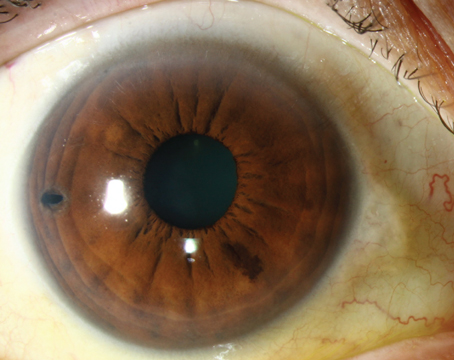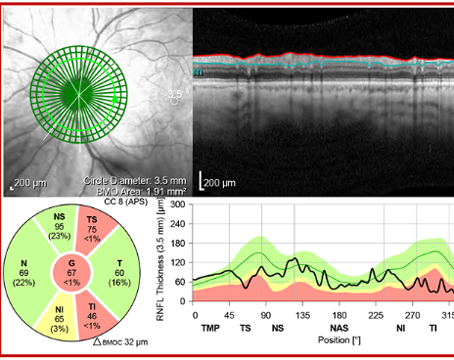Many new surgical approaches to treating glaucoma have appeared in recent years. One that's showing potential is transciliary filtration (also know as Singh Filtration). The procedure uses the Fugo blade, or plasma blade (Medisurg,
Because the plasma field generated around the tip of the Fugo blade ablates tissue rather than cutting or burning it, it is analogous to an excimer laser rather than a knife or cauterizing instrument. As a result, it produces little or no bleeding. The blade is currently approved by the Food and Drug Administration in the
Although no large, formal trials comparing TCF to trabeculectomy have yet been completed, surgeons who have extensive experience with TCF believe it has significant advantages over trabeculectomy, the current gold standard surgery.
Easy on the Surgeon
C. 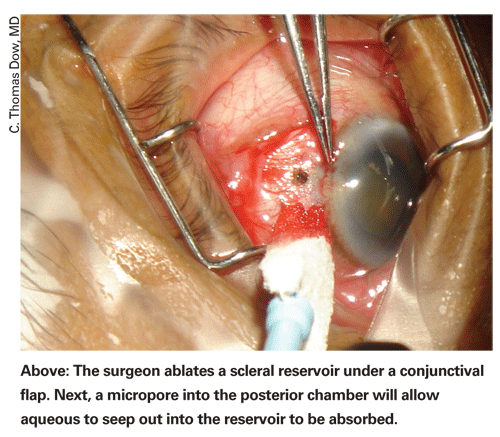
"Transciliary filtration is a very straightforward procedure, and a pleasure to do," he says. "It takes a matter of minutes and requires a single stitch. It results in a quiet eye and low pressures, and it doesn't induce any significant amount of cylinder."
Dr. Dow says TCF is very easy on the surgeon, in part because the Fugo blade "erases" tissue rather than cutting or burning it. "For instance," he says, "when you make the scleral pore using the 600-µm tip, you just erase the tissue right down to the ciliary body and create a small reservoir area in the sclera. Then you switch to the 100-µm tip and create a micropore into the posterior chamber at an angle parallel to the plane of the iris (to avoid entering the vitreous)." Dr. Dow notes that the idea of creating the reservoir came from the creator of the procedure, Dr. Daljit Singh of
Dr. Dow's extensive experience with TCF came about partly because of his charity work in the
In the
Not for Neovascular
Dr. Dow says that the one situation in which TCF seems to consistently fail is when treating neovascular glaucoma. "I've treated five patients with neovascular glaucoma, and they all failed after about a week," he says. "My guess is that the eye develops new vessels that occlude the penetration." He says that he plans to try treating with the addition of an anti-VEGF medication such as Lucentis or Avastin to see if the treatment is successful when vessel growth is slowed.
Other patients do much better. Dr. Dow says that if he eliminates the neovascular cases from the pool, about 85 percent of his patients are still filtering well after six months with no need for eye drops. "Almost no one has required any further surgery," he says. "And, I've had no flat chambers or thin, avascular blebs, which I sometimes see with other filtering procedures. I've seen no induced cylinder and no endophthalmitis. I think that compares favorably with any filtering procedure in our armamentarium.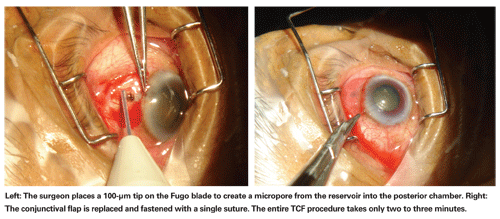
"In terms of bleeding, when I was first trying the procedure I had one case in which I hit an episcleral vessel that I couldn't see when I started, so I chose a site nearby to make the scleral pore. By the time we were doing the transciliary part of the procedure, the original bleeding had stopped. No blood got inside the eye. Some patients do develop a microscopic hyphema just because of the lower IOP, but as far as a gross bleeding problem, it just doesn't happen."
Dr. Dow says he is completing a study of 64 patient outcomes that has been submitted to Archives of Ophthalmology.
Slowly Gaining Acceptance
Dr. Dow observes that many doctors seem hesitant to try transciliary filtration. "The plasma technology used in the Fugo blade allows us to approach the eye in an anatomic area that we were trained to avoid at all costs," he notes. "That may be one of the hurdles for doctors who are considering doing this. And some may be concerned about endless shallowing of the chamber or infection, but none of those things have happened in any of the cases I've done. In my experience, these patients just don't have the problems that you see with the other filtering procedures."
Dr. Dow believes that another reason for the procedure's slow acceptance may be that when the Fugo blade first appeared, it was associated with cataract surgery capsulotomy. "The Fugo blade is beautiful for that," he says, "but the knee-jerk reaction was, 'Do we need a $20,000 replacement for a one-cent needle?' For an easy and effective glaucoma treatment, however, the cost is much more reasonable.
"Maybe this is too simple a surgery for the glaucoma subspecialist," he adds. "By the time the subspecialist sees the patient, the patient may need mitomycin or a more aggressive procedure. But any comprehensive ophthalmologist can perform transciliary filtration. It's very easy and straightforward; it's fun to do, and it works well. It's an elegant solution."
A "Balanced" Approach
Amarjit Atwal
"The problem I faced with my early cases was that my failure rate after a few weeks was quite significant," he continues. "Out of 25 or 30 procedures, 25 or 30 percent that started with excellent pressure postop had a significant rise in pressure after four or five weeks.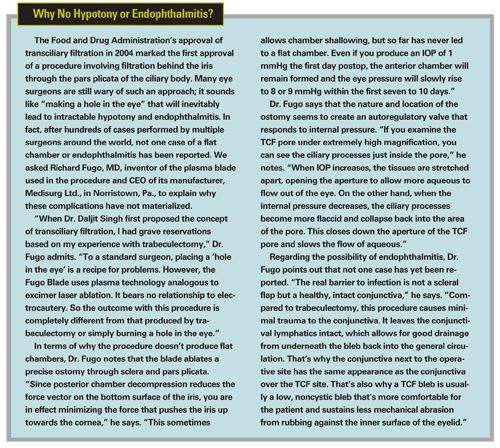
"At that point it occurred to me to try combining the procedure with microtrabeculectomy under a scleral flap, also using the Fugo blade with the same tip," he says. (He refers to this as microtrabeculectomy because the pore ablated through the tissue by the Fugo blade tip is only 100 µm wide.) "By creating a tiny opening into both the anterior and posterior chambers, the forces acting on the iris-lens diaphragm are balanced; hence the name 'Balanced Approach.'
"In contrast," he continues, "if the chamber shallows after trabeculectomy it can cause a lot of damage to the angle structures, which is one of the reasons trabeculectomies fail. Avoiding this is a huge advantage of this surgery." He adds that creating the microperforation underneath a scleral flap is important; in his experience, scarring is much more of an issue with a conjunctival flap.
Better Than Trabeculectomy?
Dr. Atwal says his success rate with his combination procedure is now about 92 percent, compared to about 70 percent with standard trabeculectomy. "I've done about 300 cases to date combining transciliary filtration with microtrabeculectomy," he explains. "More than 90 percent of these patients have no need for medications after the surgery. In the small percentage that don't achieve this, the reason is usually the patient's rate of healing. If the microperforations scar down, the patient may have to go back on medication."
Dr. Atwal says that the combined procedure is far easier than traditional trabeculectomy. "The problem with trabeculectomy is that you have to suture the flap tight," he says. "Then you loosen the suture at the follow-up.
"With my balanced approach, I don't suture the scleral flap at all," he continues. "I just suture the conjunctiva over it. I don't have to worry about overfiltration or underfiltration. It's a beautiful procedure, and it saves us a lot of work. It's changed our practice tremendously."
Dr. Atwal notes that because of a lack of hypotony and the coagulative effect that occurs when "erasing tissue" with the Fugo blade, hyphemas or bleeding at the site of the filtration are almost non-existent. "I've seen no bleeding of any significance in almost 300 cases," he says.
Dr. Atwal says he routinely schedules this procedure at the same time as cataract surgery. "Postop follow-up is no different than following up with a regular cataract patient," he notes. "However, we don't treat these patients with strong steroids, which can lead to pressure spikes in glaucoma patients. We usually just treat with nonsteroidals and mild steroids that don't raise postop pressure."
Dr. Atwal is optimistic about the future of TCF. "I believe this will ultimately change glaucoma surgery as we know it," he says. "Once surgeons begin to realize how easy it is, both in the OR and in terms of postop management, it will catch on."
